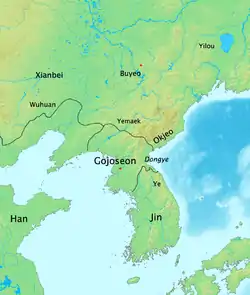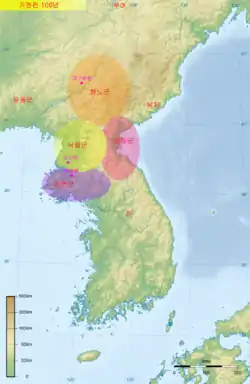Wiman Joseon
Wiman Joseon (194–108 BC) was part of the Gojoseon period of ancient Korean history. It began with Wiman's seizure of the throne from Gojoseon's King Jun and ended with the death of King Ugeo who was a grandson of Wiman. Apart from archaeological data, the main source on this period of Korean history comes from chapter 115 of Sima Qian's Shiji (Records of the Grand Historian).[1] Wiman was originally a Chinese military leader from the Kingdom of Yan under the Han dynasty.[note 1]
| Wiman Joseon | |
| Hangul | |
|---|---|
| Hanja | |
| Revised Romanization | Wiman Joseon |
| McCune–Reischauer | Wiman Chosŏn |
Part of a series on the |
||||||||
|---|---|---|---|---|---|---|---|---|
| History of Korea | ||||||||
 | ||||||||
| Prehistoric period | ||||||||
| Ancient period | ||||||||
|
||||||||
| Proto–Three Kingdoms period | ||||||||
| Three Kingdoms period | ||||||||
|
||||||||
| Northern and Southern States period | ||||||||
|
||||||||
| Later Three Kingdoms period | ||||||||
|
||||||||
| Dynastic period | ||||||||
|
||||||||
| Colonial period | ||||||||
|
||||||||
| Modern period | ||||||||
|
||||||||
| Topics | ||||||||
| Timeline | ||||||||
Founding
| Wiman Joseon monarchs | ||||||
|---|---|---|---|---|---|---|
|
||||||
According to Sima Qian, Wiman was a general from the Yan state of northeastern China after the collapse of China's Qin dynasty, who submitted to Gojoseon's King Jun. Jun accepted and appointed Wiman commander of the western border region of Gojoseon, which probably corresponds to the west of the present-day Liaoning. Despite the generosity that King Jun had demonstrated, Wiman revolted and destroyed Gojoseon. In 194 BC, he established Wiman Joseon and decided to locate his capital in Wanggeom-seong (왕검성, 王險城). Many Korean historians believe that the exact location of Wanggeom-seong was Yodong (요동) in Liaodong China.
In this period, Wiman Joseon expanded to control a vast territory and became strong economically by controlling trade between the Han Dynasty and the peoples of Manchuria. Emperor Wu of Han thought that Wiman Joseon increasingly threatened Han China, and Wiman Joseon would ally with the Xiongnu.
Fall
Wiman's grandson, King Ugeo (우거,右渠), allowed many exiles from Han dynasty of China to live in Wiman Joseon. The number of Han grew, however, and King Ugeo prevented the Jin state from communicating with the Han dynasty. As a result, in 109 BC, Wudi of China invaded Wiman Joseon near the Luan River. After failing several times to defeat Wiman Joseon's armies, Han Wudi tried to convince the princes of Wiman Joseon to kill King Ugeo. The conspiracy failed and it led to the destruction of the Gojoseon kingdom. After the war Wudi of Han dynasty sentenced two generals to death for failing to defeat Wiman Joseon.
After a year of battle, Wanggeom-seong was captured and Wiman Joseon was destroyed. Han dynasty established the Four Commanderies of Han in the captured areas, which corresponds to the current area of Liaodong peninsula and the northwestern Korean peninsula. The Commanderies eventually fell to the rising Goguryeo in 4th century AD.
Several nations were formed in its place. Among them was the Nangnang Nation. The Nangnang Nation must be differentiated from the Lelang commandery.[2]
Monarchs of Wiman Joseon
Maps
 Korea in 108 BC. Gojoseon before destroyed by Han dynasty.
Korea in 108 BC. Gojoseon before destroyed by Han dynasty. Han Dynasty destroys Wiman Joseon, and establishing the Four Commanderies.
Han Dynasty destroys Wiman Joseon, and establishing the Four Commanderies. Korea in 315. Goguryeo recovered the former Gojoseon territory.
Korea in 315. Goguryeo recovered the former Gojoseon territory.
See also
- List of Korea-related topics
- History of Korea
- List of Korean monarchs
Notes
- Watson, Burton, tr. Records of the Grand Historian: Han Dynasty II. Revised edition. New York, Columbia University Press, 1993. p. 225-230.
- Lee Hyun-Hee; Park Sung-Soo; Yoon Nae-Hyun (2005). New History of Korea. Jimundang.
References
- Yap, Joseph P. (2009). "Chapter 5. 109 BC". Wars With the Xiongnu: A Translation From Zizhi tongjian. AuthorHouse. ISBN 978-1-4490-0604-4.
Notes
-
- Peterson, Mark (2009). Brief History of Korea. Infobase Publishing. p. 6. ISBN 978-1-4381-2738-5.
- "The term was used again by a refugee from the Han dynasty named Wiman, who about 200 B.C.E. set up a kingdom in Korea called Wiman Choson."
- Cotterell, Arthur (2011). Asia: A Concise History. Wiley. ISBN 978-0470825044.
- "The earliest documented event in Korean history involves China. After an unsuccessful rising against the first Han emperor Gaozu, the defeated rebels sought refuge beyond the imperial frontier and one of them Wiman, took control of Choson, a Korean state in the north of the peninsula."
- Kim, Jinwung (2012). A History of Korea: From "Land of the Morning Calm" to States in Conflict. Indiana University Press. p. 10. ISBN 978-0253000248.
- "For instance, Wiman, a refugee from the Yan dynasty, which then existed around present-day Beijing, led his band of more than 1,000 followers into exile in Old Chosŏn in the early second century bc."
- Kim, Jinwung (2012). A History of Korea: From "Land of the Morning Calm" to States in Conflict. Indiana University Press. p. 16. ISBN 978-0253000248.
- "Wiman Chosŏn In the fourth century bc Old Chosŏn was bordered on the west, far beyond the Liao River, by the northern Chinese dynasty of Yan."
- Kim, Jinwung (2012). A History of Korea: From "Land of the Morning Calm" to States in Conflict. Indiana University Press. p. 18. ISBN 978-0253000248.
- "Immediately after destroying Wiman Chosŏn, the Han empire established administrative units to rule large territories in the northern Korean peninsula and southern Manchuria."
External links
- http://www.country-data.com/cgi-bin/query/r-9500.html
- http://www.nationsencyclopedia.com/Asia-and-Oceania/Korea-Democratic-People-s-Republic-of-DPRK-HISTORY.html
- http://www.bartleby.com/65/ko/Korea.html
- https://web.archive.org/web/20030310223530/https://www.metmuseum.org/toah/ht/04/eak/ht04eak.htm
- https://web.archive.org/web/20060301054640/http://www.metmuseum.org/explore/publications/pdfs/korea/divided/History-Religions.pdf
- https://www.nytimes.com/books/first/c/cumings-korea.html?_r=1&oref=slogin
- http://www.mmtaylor.net/Literacy_Book/DOCS/Part_2_Korea.html